Corypha palm, Sugar palm
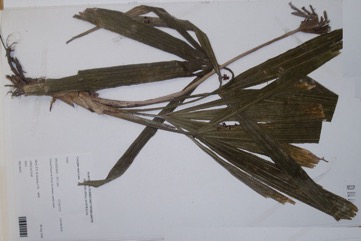
It is a tropical plant. It grows along the edges of tidal rivers. They are often on heavy soils on flood plains which flood. It grows best with access to ground water. They are very common and widely distributed at low and medium altitudes from northern Luzon to Sulu in the Philippines. It is frost tender when young. It needs a warm sunny position and a well drained soil. In Indonesia it grows up to 200 m above sea level. In Papua New Guinea it grows in the Western Province. It suits hardiness zones 11-12.
Also known as:
Bajur, Bajoon, Bajurgatul, Buoon cao, Buri palm, Gebang palm, Gewang, Gulwirri, Ibus, Komolu Silag, Lan phru, Las, Lontar utan, Pe-bin, Pochok, Puchuk, Tali
Synonyms
- Corypha elata Roxb.
- Corypha gebanga (Blume) Blume
- Taliera gebanga Blume
Edible Portion
- Starch, Kernel, Seeds, Cabbage, Sap, Sago, Nuts, Palm heart, Flower buds
Where does Corypha palm grow?
Found in: Asia, Australia, Bangladesh, East Timor, Fiji, India, Indochina, Indonesia, Laos, Malaysia, Mayotte, Myanmar, Pacific, Papua New Guinea, PNG, Philippines, SE Asia, South America, Sri Lanka, Timor-Leste, Venezuela, Vietnam, West Timor
Notes: There are 8 Corypha species.
Status: The starch is important in PNG during times of drought.
Growing Corypha palm, Sugar palm
Cultivation: Plants are grown from seed. Seed can take 18 months to germinate. Fresh seed germinate more quickly. They can germinate in less than one month. Seedlings are difficult to transplant.
Edible Uses: The starch extracted from the stem is edible. The palm cabbage or bud can be eaten raw or cooked. The sap can be collected from the flower stalk and made into sugar or toddy. The kernels of the young fruit can be eaten raw.
Production: Seedlings are very slow growing. After 40-50 years it flowers, then the leaves and palm die. So each plant can only have its sap tapped once in a lifetime. The cabbage can be removed before the palm dies.
Nutrition Info
per 100g edible portion| Edible Part | Energy (kcal) | Protein (g) | Iron (mg) | Vitamin A (ug) | Vitamin c (mg) | Zinc (mg) | % Water |
|---|---|---|---|---|---|---|---|
| - | - | - | - | - | - |
Corypha palm, Sugar palm Photos

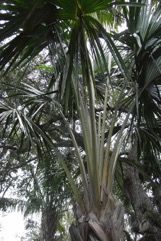
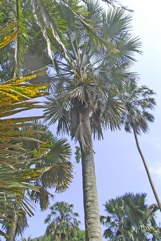
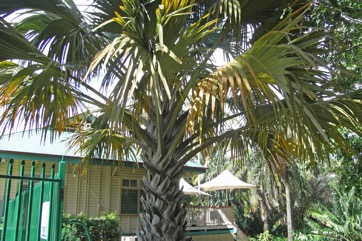
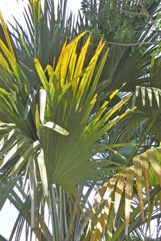

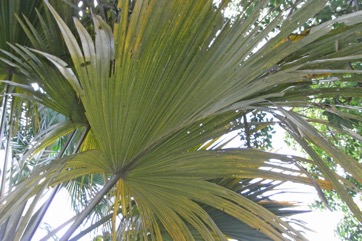
References
Ambasta, S.P. (Ed.), 2000, The Useful Plants of India. CSIR India. p 143
Baker, W.J. and Dransfield, J., 2006, Field Guide to Palms of New Guinea. Kew p 30
Balick, M.J. and Beck, H.T., (Ed.), 1990, Useful palms of the World. A Synoptic Bibliography. Colombia p 652,
Barfod, A.S., Banka R., and Dowe, J. L., 2001, Field Guide to Palms in Papua New Guinea. AAU Reports 40 Department of Systematic Botany University of Aarhus. Denmark. p 25
Beasley, J., 2011, Plants of Tropical North Queensland - the compact guide. Footloose publications. p 63
Blomberry, A. & Rodd, T., 1982, Palms. An informative practical guide. Angus & Robertson. p 93 (As Corypha elata), 121 (As Corypha gebanga), 163 (As Corypha elata), 216 (As Corypha elata), 350 (As Corypha elata),
Brock, J., 1993, Native Plants of Northern Australia, Reed. p 126 (As Corypha elata)
Brown, W.H., 1920, Wild Food Plants of the Philippines. Bureau of Forestry Bulletin No. 21 Manila. p 28 (As Corypha elata)
Burkill, I.H., 1966, A Dictionary of the Economic Products of the Malay Peninsula. Ministry of Agriculture and Cooperatives, Kuala Lumpur, Malaysia. Vol 1 (A-H) p 676
Call, C. A., et al, 2004, Participatory Rural Appraisal in the Upland Ecosystem of Mt Malindang, Misamis Occidental, Philippines. Biodiversity Research Programme for Development in Mindanao. p 53
Checklist of NT Vascular Plant Species. January 2003.
Cherikoff V. & Isaacs, J., The Bush Food Handbook. How to gather, grow, process and cook Australian Wild Foods. Ti Tree Press, Australia p 198 (As Corypha elata)
Cooper, W. and Cooper, W., 2004, Fruits of the Australian Tropical Rainforest. Nokomis Editions, Victoria, Australia. p 70
Cowie, I, 2006, A Survey of Flora and vegetation of the proposed Jaco-Tutuala-Lore National Park. Timor-Lests (East Timor) www.territorystories.nt/gov.au p 43
Cronin, L., 1989, The Concise Australian Flora. Reed. p 236 (As Corypha elata)
Cronin, L., 2000, Australian Palms, Ferns, Cycads and Pandans. Cronin Publications. p 78
Cundall, P., (ed.), 2004, Gardening Australia: flora: the gardener's bible. ABC Books. p 424
Dobriyal, M. J. R. & Dobriyal, R., 2014, Non Wood Forest Produce an Option for Ethnic Food and Nutritional Security in India. Int. J. of Usuf. Mngt. 15(1):17-37
Elliot, W.R., & Jones, D.L., 1984, Encyclopedia of Australian Plants suitable for cultivation. Vol 3. Lothian. p 103 (As Corypha elata)
Encycl. 2:131. 1786
Etherington, K., & Imwold, D., (Eds), 2001, Botanica's Trees & Shrubs. The illustrated A-Z of over 8500 trees and shrubs. Random House, Australia. p 234 (As Corypha elata)
Facciola, S., 1998, Cornucopia 2: a Source Book of Edible Plants. Kampong Publications, p 28 (As Corypha elata)
Food Composition Tables for use in East Asia FAO http://www.fao.org/infoods/directory No. 833
Friday, J. B., 2005, Forestry and Agroforestry Trees of East Timor. http://www.ctahr.hawaii.edu/forestry/data/Timor/Timor trees.html
Garde, M., et al, 2003, A Preliminary List of Kundedjnjenghmi Plant Names. Northern Land Council. (Arnhem Land, Australia) (As Corypha elata)
Gibbons, M., 2003, A pocket guide to Palms. Chartwell Books. p 93
Gibbons, M., 1993, Palms. Compact study Guide and Identifier. Sandstone. p 37 (As Corypha elata)
Haynes, J., & McLaughlin, J., 2000, Edible palms and Their Uses. University of Florida Fact sheet MCDE-00-50-1 p 5
Hedrick, U.P., 1919, (Ed.), Sturtevant's edible plants of the world. p 222 (As Corypha gebanga)
Hibbert, M., 2002, The Aussie Plant Finder 2002, Florilegium. p 75
http://palaeoworks.anu.edu.au/Nuno_PhD/04.pdf
Johnson, D.V., 1998, Tropical palms. Non-wood Forest products 10. FAO Rome. p 46, 122, 130
Jones, D.L., 1994, Palms throughout the World. Smithtonian Institution, Washington. p 51, 57, 202
Jones, D.L., 2000, Palms of Australia 3rd edition. Reed/New Holland. p 84
Martin, F.W. & Ruberte, R.M., 1979, Edible Leaves of the Tropics. Antillian College Press, Mayaguez, Puerto Rico. p 210 (As Corypha elata)
Monsalud, M.R., Tongacan, A.L., Lopez, F.R., & Lagrimas, M.Q., 1966, Edible Wild Plants in Philippine Forests. Philippine Journal of Science. p 518 (As Corypha elata)
Ochse, J. J. et al, 1931, Vegetables of the Dutch East Indies. Asher reprint. p 566
PROSEA handbook Volume 9 Plants yielding non-seed carbohydrates. p 170
Riffle, R.L. & Craft, P., 2003, An Encyclopedia of Cultivated Palms. Timber Press. p 316
Singh, H.B., Arora R.K.,1978, Wild edible Plants of India. Indian Council of Agricultural Research, New Delhi. p 81
Smith, A.C., 1979, Flora Vitiensis Nova, Lawaii, Kuai, Hawaii, Volume 1 p 399 (As Corypha elata)
Smith, N. M., 1991, Ethnobotanical Field Notes from the Northern Territory, Australia, J. Adelaide Bot. Gard. 14(1): 1-65 (As Corypha elata)
Townsend, K., 1994, Across the Top. Gardening with Australian Plants in the tropics. Society for Growing Australian Plants, Townsville Branch Inc. p 140
Tucker, R., 1988, The Palms of Subequatorial Queensland. Palm and Cycad Society of Australia, Milton, Queensland. p 28 (As Corypha elata)
World Checklist of Useful Plant Species 2020. Royal Botanic Gardens, Kew
Yunupinu Banjgul, Laklak Yunupinu-Marika, et al. 1995, Rirratjinu Ethnobotany: Aboriginal Plant Use from Yirrkala, Arnhem Land, Australia. Northern Territory Botanical Bulletin No 21. Parks and Wildlife Commission of the Northern Territory. p 30.